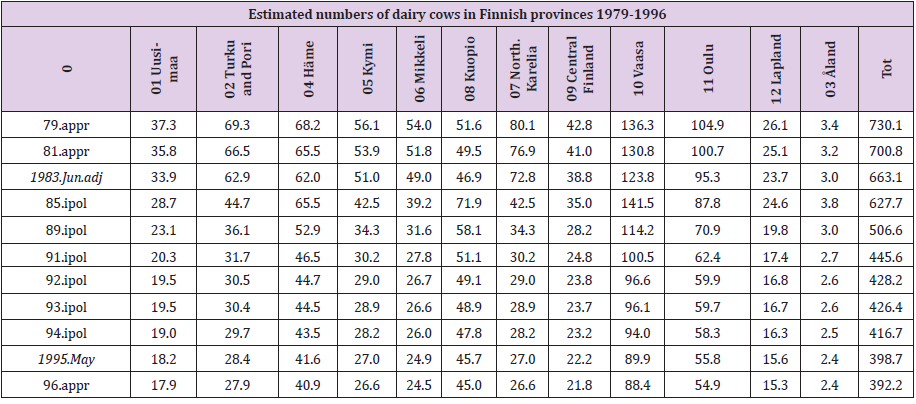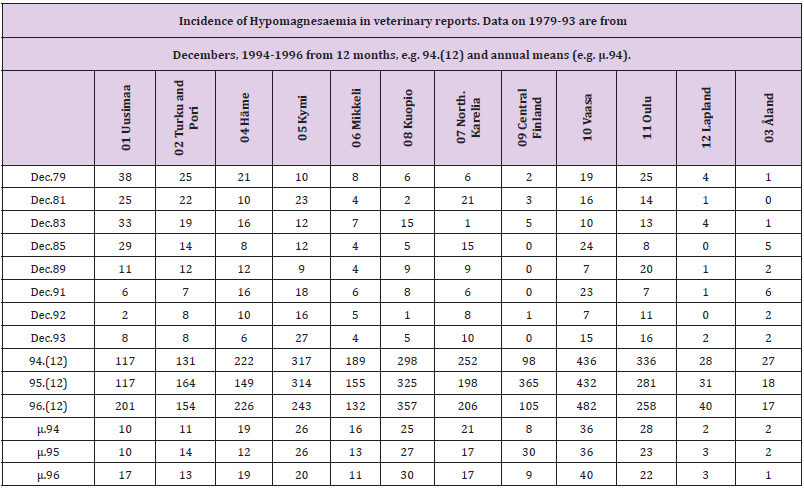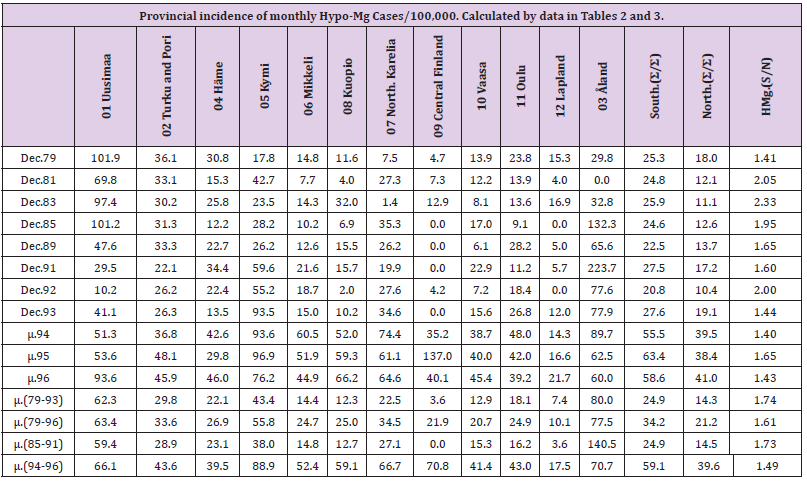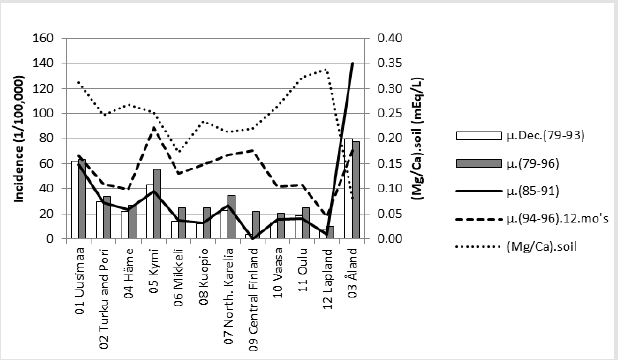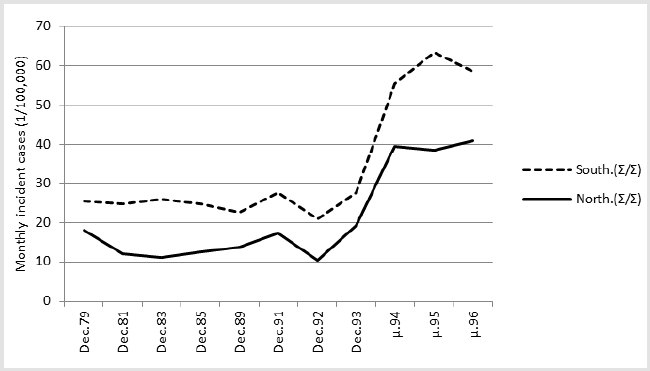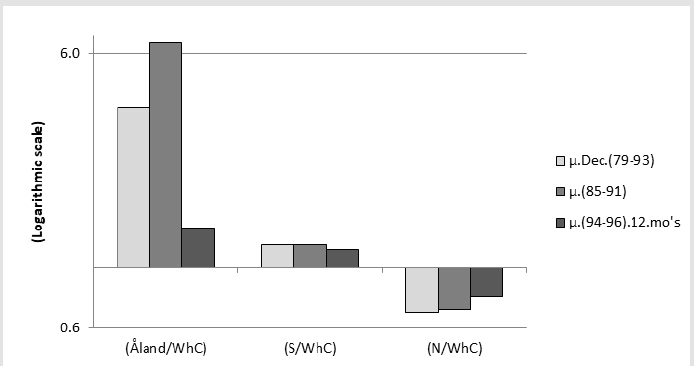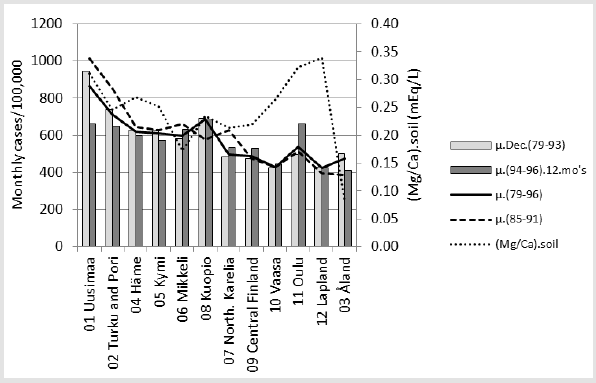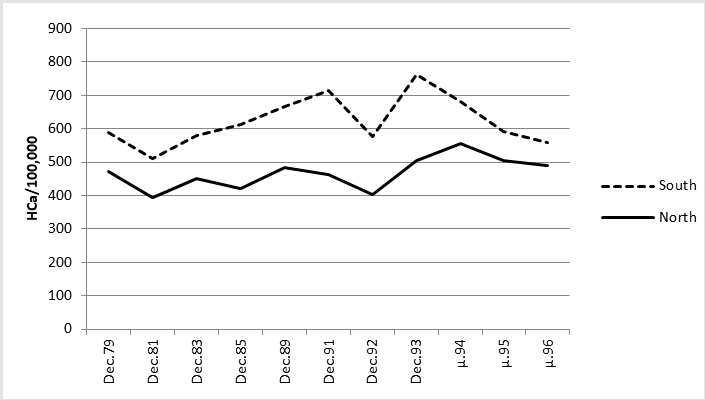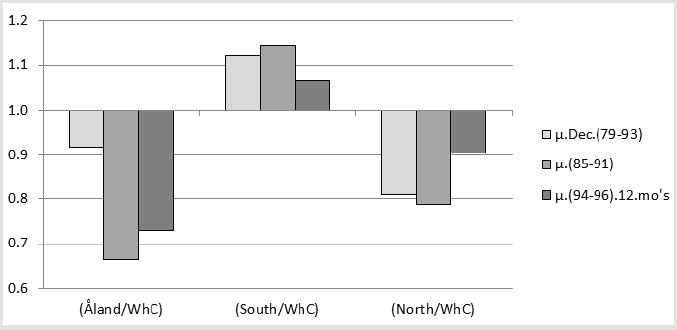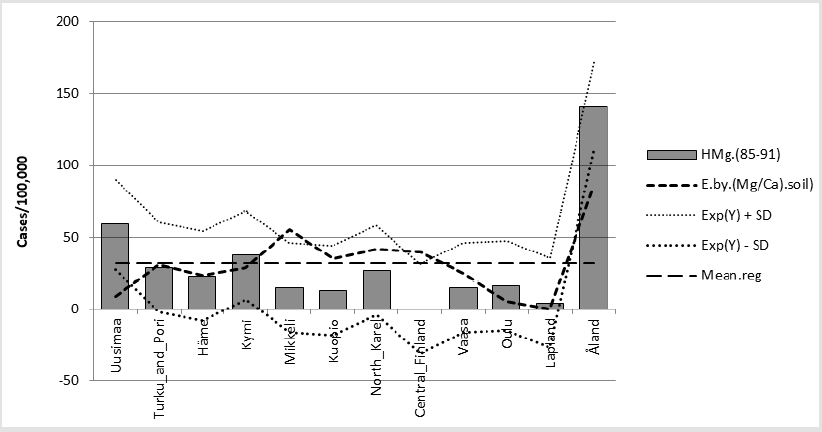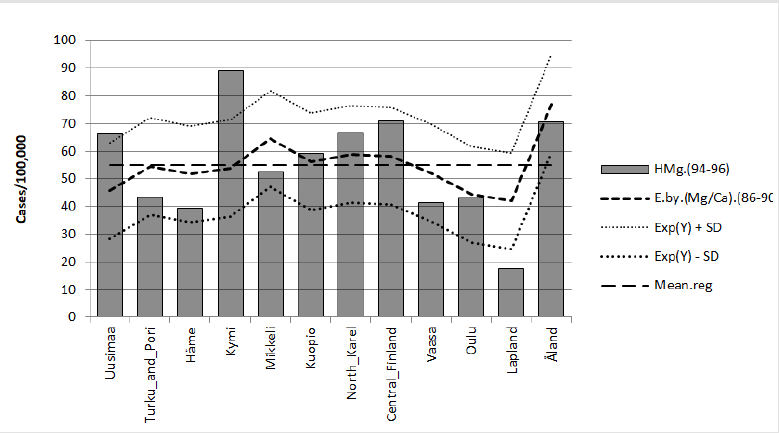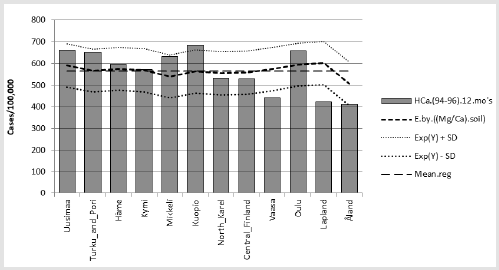Abstract
Hypomagnesaemia (HMg) of ruminats is a metabolic disease associated with relative or absolute dietary Mg-defic¬iency and climatic factors with rapid onset and remarkable lethality. Parturient Hypocalcaemia (HCa) occurs usually within 72 hours after parturition. Cropland Mg/Ca ratio has explained timothy Mg/Ca variation by 71 % (p = 0.001). Finnish (Mg/Ca).soil has been highest in North Finland during 1966- 90, but regional difference decreased thereafter. This study is assessing associations between HMg and HCa of Finnish milking cows in 1979-96 with (Mg/Ca).soil from 1986-90 [(Mg/Ca).soil]. Cow data includes provincial annual data from1994-1996 and only December data from years 1979, 1981, 1983, 1985, 1989, 1991, 1992 and 1993. Cow incidence data (1/100,000)/month is represented by figures and calculations. Because of some missing data from 1979-93, calculations are given mainly from period 1994-96, “(94-96)”, including 8,361 HMg and 107,988 HCa cases. Number of provinces was 12. Results are given by North and South Finland, too.
Results: [(Mg/Ca).soil] explained about coincidental [HMg.(85-91)] negatively by 38 % (p = 0.032) and trend-like negatively [HMg.(94-96] (by 25 %, p = 0.100) and positively HCa (by 6.8 %, p = 0.413). HMg and HCa incidence were higher in South, but relative incidence of Åland (with high Ca/Mg ratio) to /Whole Country) was 0.73 by HCa.
Conclusion: Association of cropland Mg/Ca ratio with HMg and HCa was similar but much weaker than expected by the soil-timothy studies in the 1970’s. As a background phenomenon soil Mg/Ca could affect slightly on Ca and Mg balance of animals and humans, negatively and positively. Comparing of HMg and HCa incidence especially in carbonate soils are suggested
Keywords: Regional; Hypomagnesaemia; Hypocalcaemia; Mg/Ca ratio; Cropland; Dairy Cows; Veterinary Reports
Abbreviations: HCa – parturient hypocalcaemia; HMg – Hypo-Mg, hypomagnaesemia; [(Mg/Ca).soil] – Mg/Ca ratio in Finnish croplands in 1986-90; μ.HCa – monthly cases of HCa/100,000; μ.HMg – monthly cases of HMg/100,000; N – North, combination of Vaasa, Oulu and Lapland provinces; RC - Rural Centers; S – South, combination of other than North provinces; WhC – whole country
Introduction
Hypomagnesemia (HMg) of ruminats is a metabolic disease associated with absolute or relative dietary Mg-deficiency [1] and weather conditions [2] with rapid onset and remarkable lethality. The risk is increased when cows are grazing pasture, especially in Spring and Autumn when the absorption of magnesium is influenced by factors including: high levels of potassium, nitrogen and moisture content and low levels of sodium [1]. Weather conditions, e.g. cold weather associated with low sugar content of grass can be a decisive factor [2]. Parturient Hypocalcaemia (HCa) (in Finnish “poikimahalvaus”), with synonyms: Puerperal Tetany, Lactation Tetany, Milk fever, occurs usually within 72 hours after parturition, associated with the increased calcium demand and probably are the reflection of a temporary failure of calcium homeostatic mechanisms [3]. Cropland Mg/Ca has explained timothy Mg/Ca variation 71 % (p = 0.001) [4-6]. It has been highest in North Finland (North) and lowest in Åland [7]. This study assesses provincial HMg and HCa changes during 11 periods and their associations with [(Mg/Ca).soil] from 1986-1990. Since 1983 veterinary surgeons have reported grass tetany (“laidunhalvaus”) and other “hypomagnesemias” under label “hypomagnesemia”.
Materials and Methods
Cropland magnesium and calcium values by Rural Centers (RC), mg/l, are from [8] and represented in [7] (Total”). Provincial Mg and Ca values are attained by dividing and combinig RC values as represented in [9]. They are represented as mEq/L in Table 1. Map and label numbers of Finnish Provinces are from [10], but they are put to the same order as respective RC’s in [7,8]: (08 Kuopio, 07 North Karelia; last 03 Åland). In [7] Kuopio RC/province had high (Mg/Ca) ratio in 1966-70, but relatively lower in 1986-90 [9]. That’s why Kuopio province was discarded and Vaasa province, (which includes even the biggest part of RC16, Central Ostrobothnia) [9,10] was accepted to North (group) with Oulu and Lapland. Uusimaa and Häme with higher (Mg/Ca) ratio than Vaasa were discarded from the North because North has some climatic factors in common and correlations are calculated by provinces. Because of scanty data (of HMg) whole country (WhC), South (S) and North (N) values were calculated by dividing their total incident cases by their total number of cows (Σ/Σ).
Number of milk/dairy cows (cows) by provinces for December 1983 are attained from [11], for May 1995 by Rural Business Districts from [12]. By [12] provincial data were formed as in [9], with one exception: cow number for Åland was readily given. Data of December 1983 was adjusted to June 1983 by multiplying the provincial numbers by ratio of dairy cows in May 1983 (663.1) [13] and December 1983 (634.2) [11]. Total number of dairy cows for 1979 is from [13], for 1980-1996 from [14]. Cow number estimates for other than 1983 and 1995 are attained by linear interpolation by total numbers (Table 2). By weighting provincial values by cow number 1983 or 1995 South/East ratio of (Mg/Ca) increases to 0.82-0.83. This suggests on lower Mg/Ca ratio in food/fodder [6]. Provincial data for Hypomagnesemia (Hypomagnesemia and “Laidunhalvaus” together) and Parturient hypocalcaemia (HCa), “Poikimahalvaus” are from monthly reports of veterinary surgeons to Ministry of Agriculture and Forestry [15], containing ca 15 labels of treatments for cows. This source includes data from Decembers 1979, 1981, 1983, 1985, 1989, 1991, 1992 and 1993 and annual data from 1994, 1995 and 1996 (Table 3). HMg cells from 1979- 1993 include 7 empty cells and value of 8 cells was only 1. Data on Parturient hypocalcaemia are from the same source [15] (Table 4).
Table 3: Incidence of Hypomagnesaemia in veterinary reports. Data on 1979-93 are from Decembers, 1994-1996 from 12 months, e.g. 94.(12) and annual means (e.g. μ.94).
Results
S/N ratio of HMg was always >1. In 1979-96 it was 1.74 and in 1994-96 (during 12 month data) it was 1.49 (Table 5). Monthly HMg number in 1994-96 was 2.5-fold to indoor cases in 1979-93 (Figure 1). (Pasture effect?) HMg and (Mg/Ca) values of Åland are exceptional (Figure 1). Means of indoor (December) HMg values (1979-93) correlated significantly positively with annual (1994- 96) values + 0.68 (p< 0.05). (Mg/Ca).soil (1986-90) associated most strongly, negatively and significantly, with coincidental HMg. (85-91) (r = -0.62, p < 0.05) (Figures 2&3). December HCa values (1979-93) correlated significantly positively with annual (1994- 96) values + 0.80 (p < 0.01) (Figure 4, Table 8). Ratio of HCa.(79- 93)/HCa.(94-96) was 1.0. (Mg/Ca).soil (1986-90) associated very weakly positively with HCa. Periodical S/N ratio of HCa was higher in Decembers 1979-93 (1.40), than during 12 month periods in 1994-1996 (1.18), (Table 6&7). (Protective summer effect?) HCa values of South and North seem to comply quite well, their association by Pearson correlation was +0.56 - (non-significant, p slightly > 0.05) (Figure 5-7) (Table 9-11).
Table 5: Provincial incidence of monthly Hypo-Mg Cases/100,000. Calculated by data in Tables 2 and 3.
Figure 3: HMg incidence ratios: Aland/WhC), (South/WhC) and (North/WhC), during periods 1979-93,1985-91 and 1994-96.
Table 10: Associations of periodical HCa values with each other [(1994-96), (1979-93)]and with (Mg/Ca)soil.
Results in short:
[(Mg/Ca).soil] explained [HMg.(85-91)] negatively by 38 % (p = 0.032) (Figure 8). Small number of samples can cause statistical bias. HMg cases are about coincidental with soil samples (Figures 9&10).
Figure 8: Hypomagnesemia incidence in 1985-91 and its regression by cropland Mg/Ca ratio- negative association.
Discussion
This study shows that HMg was associated trend-like negatively and HCa weakly positively with agricultural soil Mg/Ca ratio as suggested by [4-6]. Strongest HMg association (-0.62*) with [(Mg/ Ca).soil] was observed, when HMg cases were collected from about the same period. South and Nord was selected differently to [7] (Nord exluded Kuopio and included Vaasa), because of higher Mg/ Ca ratio in 1986-90 than in 1966-70. Soil (Mg/Ca) ratio in South was lower to North: S/N ratio was below 1 (0.82-0.83) even by weighting the soil values by the number of cows. Compliance between South and West values in HMg and HCa is obviously partially dependent on climatic factors. Assessing by South and North blocks can include additional bias although it could reduce statistical biases. Small number of variables (12) and small size of variables, as well as small number of provincial HMg cases in 1979- 93 could cause statistical bias. The moderately big changes in soil values during the scope of this study [7] could have affected on the results [7]. Veterinary surgeon Haaranen [16] did not see any HMg cases during 1953-66 in his district (in Kuopio province – “North”) although HMg was common in Finland before availability of Mg-rich fodder salts, since 1956 [17]. HMg risk was changed via NPK/Mg fertilization ratio [16], even associated with phosphor proportion in fodder [16]. HMg risk was obviously affected via (domestic or foreign) fodder import. Explanation for higher HMg risk in Kymi to Åland after 1992 (Table 5) is not explained here. Different roles of soil and groundwater factors are discussed in [7]. Outside of this study groundwater Mg/Ca ratio associated non-significantly negatively with HMg and positively with HCa. But water-factors seem to have difficulties in explaining their effects quantitatively.
Conclusion
Association of cropland Mg/Ca ratio with HMg and HCa was similar but much weaker than suggested by the soil timothy studies in the 1970’s. As a background phenomenon soil Mg/Ca could affect slightly on Ca and Mg balance of animals and humans, negatively and positively. Comparing of HMg and HCa incidence especially in carbonate soils are suggested.
Acknowledgement
I am grateful to Professor Osmo Hänninen and late veterinary surgeon Seppo Haaranen for several discussions.
References
- Grass tetany.
- Haaranen S (1968) Observations on hypomagnesaemia in cows with convulsive symptoms. Finnish Veterinary Journal212-223.
- Parturient Hypocalcaemia, Milk Fever, Puerperal Tetany, Lactation Tetany ... WikiVet.
- Sippola J, Tares T (1978) The soluble Content of Mineral Elements in Cultivated Finnish Soils. ActaAgriculturaeScandinavica 20: 11-25.
- Kähäri J, Nissinen H (1978) The Mineral element Contents of Timothy (Phleumpratense L.) in Finland. ActaagrScand 20(1978): 26-39.
- Toysa T, Hänninen O (2015) Agro-Geology and CHD in Finland. JJ Agriculture 1(2): 6.
- Töysä T (2020) Regional Groundwater Si and Mg/Ca, Soil Mg/Ca, Soil-Types, Cardiac Diseases and Local Long-Term Dolomite Application - Soil Values from Two Periods Suggest on Different Roles of Mg and Si in Cardiac Epidemiology. Biomed J Sci& Tech Res.
- EurofinsViljavuuspalveluOy. Liite_1.2. Average acidity of different soil types and_86_90. xls 117.50 KB [in Finnish]. (Attachment 1.2, Acidity and Mineral element contents by soil-types in Finnish Rural Centers 1986-1990.)
- Toysa T, OsmoHanninen (2016) Soil Weathering, Silicon and CHD in Finland. JJ Agriculture 2(1): 8.
- (1980) Statistical Yearbook of Finland 1980. Tilastokeskus 1981. Helsinki.
- (1983) Farm register. Official Statistics of Finland, XLIII:4. Milk cows 10.2 Number of cattle on farms on 31 December, 1983 (on p. 122). 10.2 By provinces. National board of Agriculture, Helsinki 1986.
- (1995) Yearbook on Farm statistics. SVT. Agriculture and Forestry 1995:5. Dairy cows. 2.2.1 Number of cattle by Rural Business District on 1.5.1995 (on p.79). Information Centre of the Ministry of Agriculture and Forestry. Helsinki 1995.
- (1979) Dairy cows, total, at 15 June. Table 2.2.1.1 Number of cattle by agricultural centre at 15 June 1983 and in the whole country in 1972-1983.Yearbook of Farm Statistics 1983. Official Statistics of Finland III:82. National Board of Agriculture. Helsinki 1986.
- Dairy cows, total, 1980-1996. Table 2.2.1.Number of cattle by Employment and Economic Development Centre on 1.5.1997 and in the whole country 1980-1997.Yearbook of Farm Statistics 1997. SVT Agriculture and Forestry 1997:5. Information Centre of the Ministry of Agriculture and Forestry. Helsinki 1997.Forestry 1997
- I-XI. Incidence of some animal diseases according monthly veterinary reports.(Occurrence of certain animal diseases in Finland according to the monthly reports of veterinarians). December 1979, December 1981, December 1985, December 1989, December 1991, December 1992, December 1993, Year 1994, Year 1995, Year 1996. Ministry of Agriculture and Forestry.
- Haaranen S (1970)Observations of magnesium in cattle feeding. Special issue of the Cement Association's Information Journal 15-20.
- Karjamies (1956) Mineral salts on prophylaxis of grass tetany. livestock134.

 Mini Review
Mini Review
